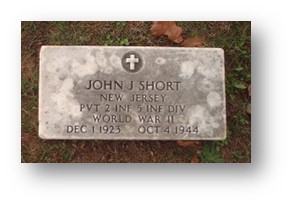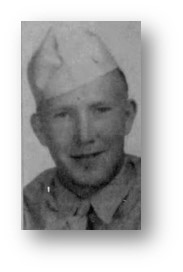Name: Short, John James, PVT, USA
Local address: 2 Gaston Avenue, Aberdeen, NJ
John’s grandfather James J. Short (1855-1918) was an Irish immigrant who settled in Matawan Township in the 1880s. He established a junk business that was active in the area for years. His son Charles Henry Short (1887-1974) married Margaret M. Bogardus (1894-1975) and they had six children, John being the fifth, born December 1, 1923 in Matawan. John’s father Charles was a chemical operator for Hercules Chemical Company in Parlin.
John graduated from St. Joseph’s School in Keyport in June of 1937 and was a member of the Matawan High School graduating class of 1941. When he registered for the draft on June 30, 1942, the record indicated he was employed at Bendix Radio in Red Bank and he was described as 5’8” tall, 140 pounds, blue eyes, blonde hair with a light complexion. In January of 1944, he was drafted into the Army and received his basic training at Camp Blanding in Starke, Fl. Upon completion of this course he was assigned to Ft. Meade, MD, and then to the 2nd Infantry Regiment attached to the 5th Infantry Division. He was then sent overseas and he and his family subsequently experienced months of uncertainty and heartbreak.
John never received any mail or packages the family sent him, writing to them wondering why he received no communications. The last letter received from him asking about this was dated September 30, 1944.
 In early November of 1944, his family received a telegram stating John had been “slightly wounded” in France on October 4th. No further information regarding this was forthcoming until over two months later, when on January 22, 1945, the family was again notified that he actually had been missing in action, not wounded, since the previous October 5th. Another two months passed when a third telegram was received March 27, 1945, stating that John was now assumed to have been killed in action on October 4th.
In early November of 1944, his family received a telegram stating John had been “slightly wounded” in France on October 4th. No further information regarding this was forthcoming until over two months later, when on January 22, 1945, the family was again notified that he actually had been missing in action, not wounded, since the previous October 5th. Another two months passed when a third telegram was received March 27, 1945, stating that John was now assumed to have been killed in action on October 4th.
Available army records indicate that John was assigned to a Company K of one of the 2nd’s battalions. In July of 1944, the 2nd landed in Normandy and its division became part of Patton’s 3rd Army, leading the breakout, capturing Rheims and seizing Metz after a major battle at Fort Driant. In this battle, John’s company was ordered to support the 11th Infantry Regiment which was in danger of being routed by German counterattacks. They suffered horrific casualties – two companies of the 11th lost half their men, but Patton refused to accept that the attack might stall and was quoted as saying “if it took every man in the XX Corps, [he] could not allow an attack by this Army to fail.” It was during this attack that John was apparently killed.
A World War II Hospital Admission Card File for John was located, dated November 1944. It indicated he was a battle casualty, killed in the line of duty with artillery shrapnel wounds to his throat. The massive amounts of casualties and the American Army’s rapid advance most likely contributed to the confusion about his wounded, MIA then KIA status. The battle for Fort Driant is believed by some military historians to have been one of the most desperate and confusing actions in the European campaign.
Originally buried in the Luxembourg Military Cemetery, John’s body was returned to Matawan in August of 1948 and is buried with many other family members in the St. Joseph’s Cemetery in Keyport.


NO COMMENTS